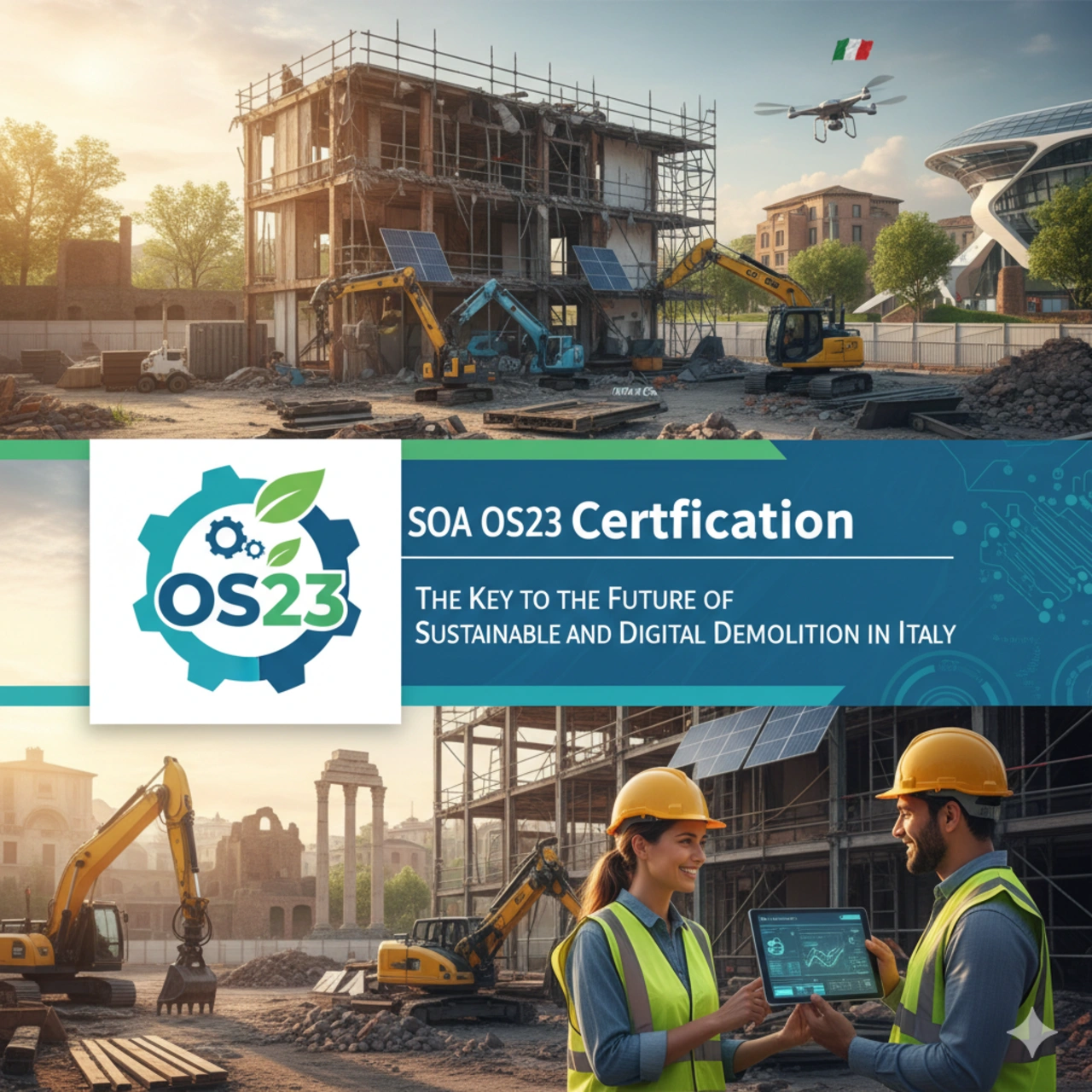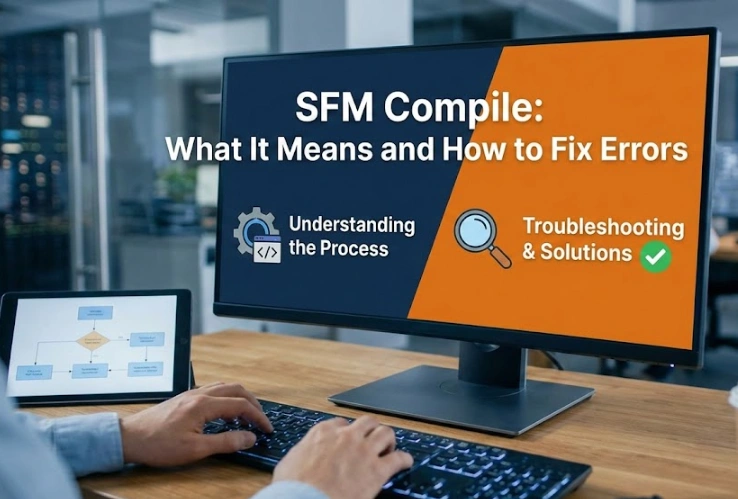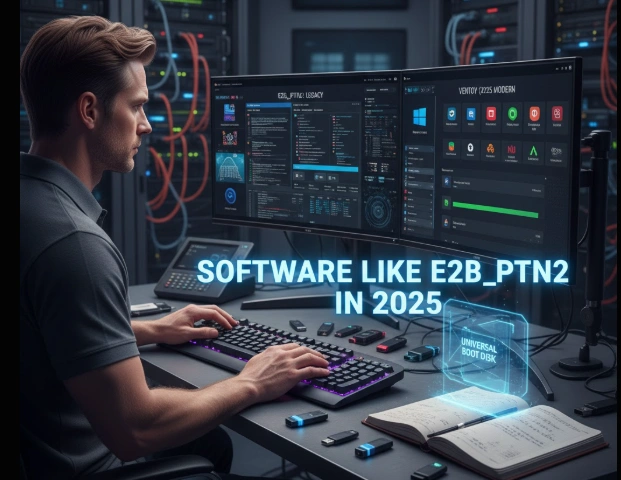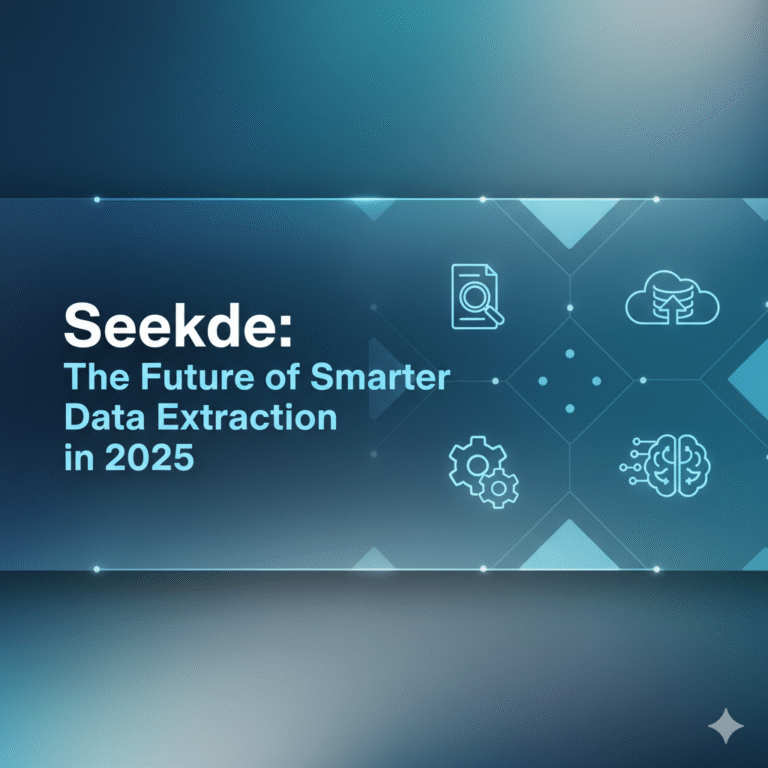SOA OS23 Certification: The Key to the Future of Sustainable and Digital Demolition in Italy
If you work in Italy’s construction or demolition industry, chances are you’ve heard the term SOA OS23 more than once. But what exactly is it — and why does it matter so much today?
Simply put, SOA OS23 is a specialized certification for demolition activities within Italy’s public works sector. It serves as proof that a company has the technical, financial, and operational qualifications to carry out demolition work safely, sustainably, and in compliance with national standards.
With stricter environmental laws, the rise of digital construction tools, and an increased push toward transparent tendering processes, SOA OS23 has transformed from a “nice-to-have” into a strategic necessity. Let’s explore how this certification is shaping the future of digital architecture, compliance, and sustainable construction.
What Is SOA OS23?
SOA OS23 stands for “Demolition of Works” (in Italian: Demolizione di Opere). It is part of the broader SOA certification system defined under the Italian Presidential Decree 207/2010, specifically in Annex A.
The certification evaluates whether a company is qualified to perform demolition work under public contracts. This includes everything from controlled dismantling of industrial structures to the removal of reinforced concrete, and even environmentally responsible material separation.
Unlike some construction categories, SOA OS23 focuses entirely on the demolition process—an often-overlooked yet essential stage of sustainable construction and urban regeneration.
Why SOA OS23 Certification Is Important in Public Tenders
In Italy, public works tenders demand transparency and reliability. For demolition-related projects, the SOA OS23 certification serves as a proof of credibility. It signals that a contractor isn’t just technically capable but also compliant with the strict safety and environmental regulations that govern demolition work.
Here’s how SOA OS23 fits into the broader SOA ecosystem:
| SOA Category | Work Type | Public Work Relevance |
|---|---|---|
| OG1 | Civil & Industrial Buildings | Mandatory |
| OG3 | Roads & Bridges | Mandatory |
| OS23 | Demolition of Works | Optional (but highly valuable) |
| OS21 | Special Structural Works | Mandatory |
While OS23 is not always legally required, it’s becoming increasingly expected in government contracts. Contractors holding the certification are often seen as more professional, compliant, and environmentally responsible—a serious advantage when competing for tenders.
Who Needs SOA OS23 Certification?
If your business involves demolition, dismantling, or site clearance, then this certification is for you. Specifically, SOA OS23 applies to companies that:
- Carry out controlled demolitions using precise methods like diamond cutting or water jet dismantling.
- Handle industrial or civil structure demolition, including high-rise or reinforced concrete removal.
- Employ eco-friendly demolition practices, focusing on waste recycling and material recovery.
Even if your company doesn’t frequently bid for public contracts, having SOA OS23 can boost your credibility with clients and partners who value certified compliance and sustainability.
The Role of SOA Certifications in Italy’s Public Works
SOA certifications were established to ensure that only qualified and compliant companies could participate in public construction and demolition projects. They assess multiple factors, including:
- Financial stability
- Technical equipment and staff capability
- Compliance with safety and environmental laws
Under Italy’s Public Procurement Code, companies must possess an SOA certificate for any contract worth more than €150,000.
Although OS23 certification isn’t compulsory for every demolition project, it significantly enhances a company’s reputation, especially for complex, high-value, or sustainable projects.
| Requirement | Purpose |
|---|---|
| Certification Standards | Demonstrates compliance with construction and demolition laws |
| Equipment and Staff Audit | Confirms readiness and safety |
| Annual Monitoring | Keeps companies aligned with new regulations |
The ultimate goal is to ensure uniform standards and safer work practices across Italy’s public works industry.
How SOA OS23 Aligns with Broader SOA Standards
SOA OS23 doesn’t operate in isolation. It often overlaps with other categories, particularly those related to building reconstruction and structural works. For instance, a demolition firm may also hold OG1 (civil buildings) or OS8 (metal structures) certifications.
This overlap reflects a growing need for multidisciplinary skills. Modern demolition projects aren’t just about tearing things down—they involve engineering precision, digital planning, and environmental accountability.
Some examples of techniques recognized within the OS23 framework include:
| Technique | Purpose |
|---|---|
| Explosive Demolition | Rapid removal of large structures |
| Hydraulic Cutting | Safe and precise structural disassembly |
| Material Sorting | Supports recycling and waste reduction |
By integrating such diverse competencies, companies can demonstrate both compliance and innovation—key pillars of modern public construction.
Trends Shaping SOA OS23 in 2025 and Beyond
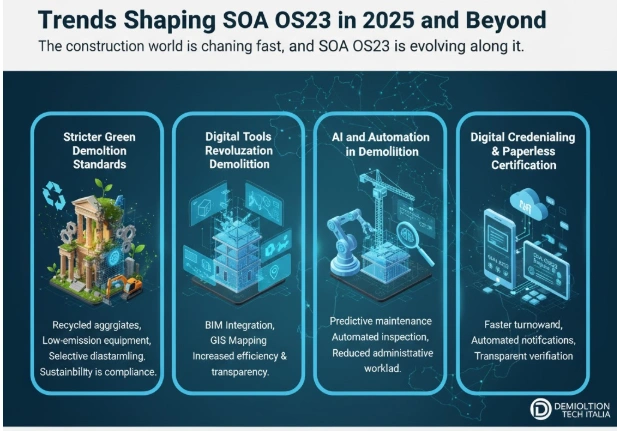
The construction world is changing fast, and SOA OS23 is evolving along with it. From sustainability to digitalization, here are the major trends shaping its future:
1. Stricter Green Demolition Standards
Environmental consciousness is no longer optional. The Italian government is pushing for greener demolition practices, requiring contractors to prioritize waste recovery and emission reduction.
Some emerging eco-friendly measures include:
- Recycled aggregates replacing traditional materials.
- Low-emission equipment to reduce carbon output.
- Selective dismantling to separate reusable components.
In short, sustainability is now a compliance requirement, not a bonus.
2. Digital Tools Revolutionizing Demolition Workflows
Technology is transforming how demolition projects are planned, executed, and documented.
Tools like Building Information Modelling (BIM) and Geographical Information Systems (GIS) are making it easier to simulate projects, anticipate risks, and secure regulatory approvals faster than ever before.
- BIM Integration helps engineers visualize every phase of demolition before it begins, minimizing errors.
- GIS Mapping enables real-time analysis of environmental and structural conditions, improving decision-making.
These digital workflows not only increase efficiency but also support transparency in tendering and reporting processes.
3. AI and Automation in Demolition
Artificial Intelligence (AI) is entering the demolition sector in a big way. From predictive maintenance of heavy machinery to automated inspection systems, AI enhances both safety and productivity.
Imagine an AI tool that can forecast when a crane or excavator might fail—or detect microstructural weaknesses in a building before demolition begins. That’s not science fiction anymore.
AI-driven systems are also reducing administrative workloads, allowing teams to focus on strategic planning instead of paperwork.
4. Digital Credentialing and Paperless Certification
Another growing trend is the digitization of the certification process itself.
SOA agencies are now adopting online portals for application submissions, document verification, and compliance tracking.
Benefits include:
- Faster certification turnaround times.
- Automated notifications about regulatory updates.
- Transparent verification through secure databases.
This shift to digital certification ensures that SOA OS23 remains relevant in the era of paperless governance and smart construction.
Challenges in Obtaining and Maintaining SOA OS23
While SOA OS23 offers tremendous advantages, obtaining and maintaining it isn’t always easy. Companies face several common challenges, such as:
| Challenge | Solution |
|---|---|
| Extensive Documentation | Hire consultants who specialize in SOA preparation. |
| Outdated Equipment | Regularly invest in modern and compliant machinery. |
| Certification Expiry | Track renewal dates with automated reminders. |
Maintaining certification requires continuous adaptation—especially as Italy’s construction regulations evolve toward greener and more digitized standards.
Tips to Simplify the SOA OS23 Certification Process
Here are some practical strategies that can make your certification journey smoother:
- Partner with Experts: Work with firms experienced in SOA certification to streamline your documentation and compliance audits.
- Stay Updated: Monitor regulatory changes—new environmental or safety norms can affect your certification scope.
- Digitize Your Workflow: Use project management software to track compliance documents and staff qualifications.
- Train Your Team: Regular training on SOA standards ensures your workforce understands both technical and legal expectations.
- Audit Regularly: Internal audits can help identify gaps before official inspections.
Proactivity is key—companies that invest in compliance now will enjoy smoother renewals and stronger reputations later.
How Digital Architecture Is Transforming Demolition Workflows
Digital transformation is no longer just a buzzword—it’s redefining how demolition projects are managed. From AI-driven project simulations to blockchain-based traceability, the integration of technology is reshaping compliance under SOA OS23.
Technology in Action:
- AI Databases: Automatically compile and analyze safety and environmental data for regulatory audits.
- Blockchain Tracking: Provides transparent and tamper-proof logs of demolition waste management.
- Remote Monitoring: Drones and IoT sensors track structural stability and air quality in real-time.
These advancements don’t just simplify compliance—they make demolition smarter, safer, and more sustainable.
Case Studies: Real-Life Digital Success Stories
Let’s look at how some forward-thinking companies are applying digital tools within the OS23 framework:
- EcoBuild Ltd used BIM to run digital safety simulations before submitting public tenders, reducing on-site incidents by 40%.
- UrbanWorks Group automated its OS23 compliance audits with GIS technology, cutting administrative time by half.
Both examples show that digital architecture is not just an upgrade—it’s a competitive edge.
The Future of SOA OS23 Compliance
The evolution of SOA OS23 signals a broader transformation in the construction industry. Compliance is no longer about ticking boxes—it’s about embracing innovation and building trust through sustainability and transparency.
To stay ahead, companies must:
- Implement long-term sustainability plans that align with Italy’s environmental goals.
- Use integrated digital platforms to manage compliance, safety, and project execution.
- Invest in staff training to build internal expertise and agility.
SOA OS23 certification isn’t just a legal document—it’s a strategic investment in your company’s future. Whether you’re a demolition contractor or a digital consultant, this qualification opens doors to growth, credibility, and collaboration.
Conclusion
The construction world is moving toward greener, smarter, and more transparent systems. The SOA OS23 certification lies at the intersection of these forces—merging technical expertise, digital innovation, and sustainability.
By obtaining and maintaining SOA OS23, businesses can position themselves as leaders in responsible demolition, ready to thrive in Italy’s rapidly modernizing public works landscape.
In short, SOA OS23 isn’t just about compliance—it’s about confidence, credibility, and commitment to the future.
FAQs
1. What exactly does SOA OS23 cover?
SOA OS23 covers demolition activities in Italy’s public works sector, including controlled dismantling, structural removal, and environmentally safe waste handling.
2. Is SOA OS23 mandatory for all demolition companies?
Not always. While it’s optional for some contracts, many public tenders now prefer or require it, making it a strong competitive advantage.
3. How long does SOA OS23 certification remain valid?
Typically, the certification lasts five years, with a mid-term check after three years to confirm ongoing compliance.
4. Can digital tools help with SOA OS23 compliance?
Absolutely. Tools like BIM, GIS, and AI-powered audits simplify documentation, improve accuracy, and support paperless certification workflows.
5. Is SOA OS23 recognized outside Italy?
No, it’s specific to Italy’s public procurement system. However, holding this certification demonstrates a company’s adherence to high international safety and sustainability standards.

